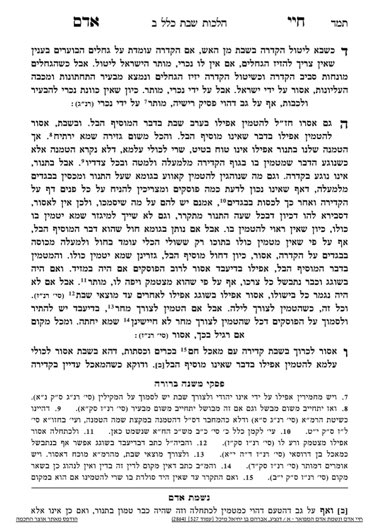We are beginning siman 6. The Chayei Adam begins the siman by repeating a point he made before. He writes that it is assur to wrap a pot completely in blankets or covers, even if the covers are not mosif hevel, once Shabbos has begun. Thus, a person cannot take a pot out of the oven and wrap it completely in insulating material, even if the material will not be mosif hevel.
The Chayei Adam adds a leniency. He writes that the issur hatmana of Chazal only applies to the pot in which the food was cooked. The walls of the original pot, which is a kli rishon, are hot enough to continue to warm the food inside, so it was on such a pot that Chazal were concerned one would come to stir the coals and heat the food. If one empties the pot into another pot, the second pot is a kli sheini, and starts out at room temperature, so it diminishes the heat. When the person does an act which diminishes the heat, it indicates that they are not so concerned about the heat, so the concern which propelled Chazal to enact the issur of hatmana–that someone may be so concerned about heat they will stir the coals–does not apply. Therefore, if one pours out their food into another pot, there is no concern of hatmana on the second pot. It is muttar to empty the pot into another pot on Shabbos itself, and certainly before Shabbos as well.
The Mishnah Berurah points out that even if one subsequently pours the food back into the original pot, hatmana is muttar. Again, since the person has demonstrated that they are not concerned for the heat, there is no concern for hatmana.
There is no problem of hatmana when the pot itself is the insulator. For example, it is muttar to cook inside an insulated thermos before Shabbos and then keep the food inside the thermos going into Shabbos.
The Chayei Adam continues, and writes that if an item was in a state of hatmana before Shabbos, it is muttar to take it out of the state of hatmana and then return it to the state of hatmana after Shabbos has begun. The issur is to initiate hatmana; once the hatmana has been initiated before Shabbos, it is muttar to return it to that state. The Chayei Adam adds that one can even add more layers of insulation when they return the item. However, the Chayei Adam will clarify that one can only add insulation when the item is fully cooked. We will discuss this point in the upcoming shiur, be’ezras Hashem.
Summary
- The issur hatmana only applies to the pot in which the food was cooked; if one empties the food into another pot, there is no issue of performing hatmana on the second pot.
- Similarly, one can pour the food back into the original pot as well.
- There is no issur of hatmana when the pot itself is the insulator, such as cooking in a thermos.
- Once a food item was in a state of hatmana before Shabbos, it is muttar to take it out of that state and then return it to a state of hatmana after Shabbos has begun.



